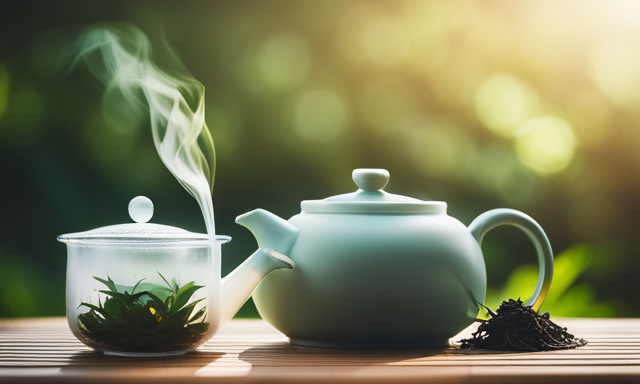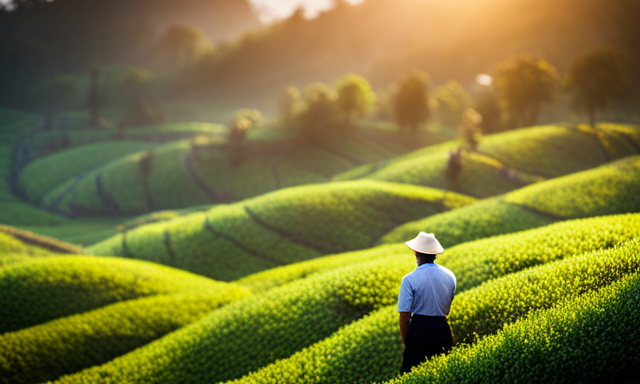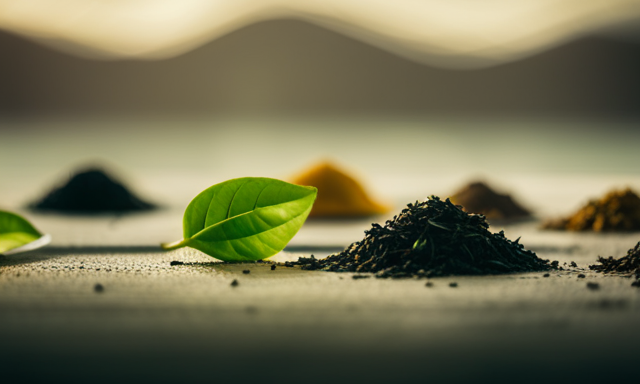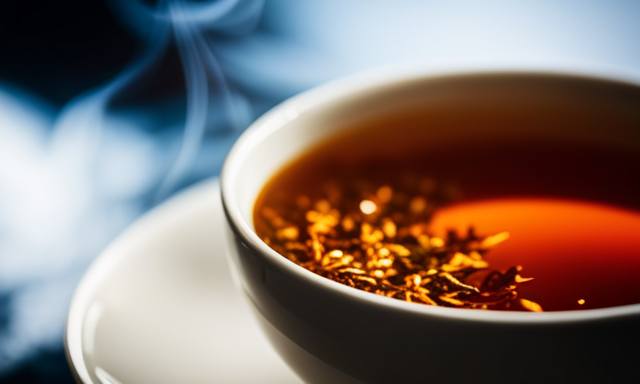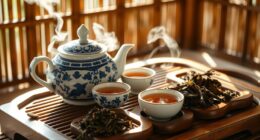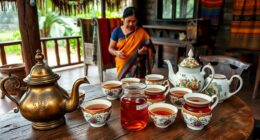As I sit here, savoring a cup of oolong tea, I can’t help but wonder about other teas that share its unique qualities. Oolong tea, with its delicate balance of flavors and enticing aroma, is truly a treat for the senses.
But what if you’re in the mood to explore other teas that offer a similar experience? Fear not, for I am here to guide you on this flavorful journey.
In this article, we will dive into the world of teas that bear resemblance to oolong tea, each with its own distinctive characteristics. From the bold and robust nature of black tea, to the light and refreshing notes of green tea, we will explore a variety of options that are sure to pique your interest.
So, grab your favorite teacup, settle in, and let’s discover the teas that are akin to oolong tea’s exquisite charm.
Key Takeaways
- Black tea is the closest alternative to oolong tea in terms of flavor and aroma, with a robust and bold taste.
- Green tea offers a delicate and refreshing flavor profile, packed with antioxidants to protect cells and reduce chronic disease risk.
- White tea shares similar health benefits and brewing techniques with oolong tea, known for its delicate and subtle flavor.
- Pu-erh tea, with its earthy aroma and rich flavor, aids digestion, promotes weight loss, and may have antioxidant and anti-inflammatory properties.
Black Tea
If you’re a fan of oolong tea, you’ll love black tea too!
Black tea is one of the closest alternatives to oolong tea in terms of flavor and aroma.
It undergoes a full oxidation process, giving it a robust and bold taste.
Just like oolong tea, black tea is rich in antioxidants, which can help boost your immune system and improve overall health.
Additionally, black tea has been linked to various health benefits, including improved heart health and reduced risk of stroke.
Its caffeine content is moderate, providing a gentle energy boost without the jitters.
Now, let’s delve into the world of green tea and discover how it differs from both oolong and black tea.
Green Tea
Green tea is like a taste explosion in your mouth. Its delicate flavor profile is both refreshing and invigorating.
When it comes to health benefits, green tea is a true powerhouse. Here are three reasons why green tea should be a part of your daily routine:
-
Rich in antioxidants: Green tea is packed with catechins, a type of antioxidant that helps protect cells from damage and reduce the risk of chronic diseases.
-
Boosts brain function: The combination of caffeine and the amino acid L-theanine in green tea can improve brain function, enhance focus, and increase alertness.
-
Supports weight loss: Green tea has been shown to boost metabolism and help with fat burning. It can also aid in appetite control, making it a great addition to a healthy weight loss plan.
As we move on to discuss white tea, let’s explore its unique qualities and benefits.
White Tea
White tea is a fascinating topic to delve into. It is known for its delicate and subtle flavor, making it a favorite among tea connoisseurs.
One key characteristic of white tea is its minimal oxidation process, which results in a unique and light taste.
As someone who appreciates the intricacies of tea, I find white tea to be a fascinating exploration of flavor and craftsmanship.
Delicate and Subtle Flavor
Nothing beats a tea similar to oolong tea for a delicate and subtle flavor. This type of tea shares many characteristics with oolong tea, including its health benefits and brewing techniques.
When it comes to health benefits, oolong tea and similar teas are known for their high levels of antioxidants, which can help boost the immune system and reduce the risk of chronic diseases. Additionally, these teas have been found to aid in weight management and improve digestion.
When it comes to brewing techniques, oolong tea and similar teas require careful attention to water temperature and steeping time to achieve the perfect balance of flavors. By practicing these techniques, one can unlock the full potential of these teas and enjoy their delicate and subtle flavors.
Moving on to the next section, let’s explore the concept of minimal oxidation.
Minimal Oxidation
To truly appreciate the art of tea, one must embrace the concept of minimal oxidation. This process ensures that the leaves undergo just enough transformation to create a symphony of flavors that dance on the palate.
The benefits of minimal oxidation in tea production are numerous. It preserves the delicate and subtle flavors of the tea while maintaining its natural freshness. By minimizing oxidation, the tea steers clear of bitterness, allowing for a smoother and more enjoyable taste experience.
Comparing the taste profiles of minimally oxidized teas, one can find a wide range of flavors, from floral and fruity to nutty and grassy. Each tea variety offers a unique sensory journey, captivating the senses with its exquisite taste.
As we delve into the world of pu-erh tea, we discover yet another facet of tea craftsmanship that will transport us to a different realm of flavors.
Pu-erh Tea
Pu-erh tea, with its earthy aroma and rich flavor, offers a unique and distinct alternative to oolong tea. Derived from Yunnan Province in China, this fermented tea undergoes a special aging process, resulting in a dark, robust brew that is treasured by tea enthusiasts worldwide. Apart from its distinctive taste, pu-erh tea is also known for its numerous health benefits. It is believed to aid digestion, promote weight loss, and lower cholesterol levels. Studies suggest that pu-erh tea may also have antioxidant and anti-inflammatory properties, making it a popular choice for those seeking to improve their overall well-being. To further capture the essence of pu-erh tea, let’s explore a comparison between this exquisite tea and the delicate darjeeling tea, known for its floral notes and delicate flavor profile.
Darjeeling Tea
Darjeeling tea is a highly regarded tea known for its muscatel flavor notes and light oxidation.
The muscatel flavor gives the tea a unique and distinct taste, reminiscent of grapes or wine.
The light oxidation process used in the production of Darjeeling tea helps to maintain its delicate and floral flavors.
Muscatel Flavor Notes
When sipping oolong tea, you can taste the delightful essence of muscatel, like the sweet whisper of a grapevine dancing on your palate. The muscatel flavor notes in oolong tea are reminiscent of the floral notes and fruity undertones found in Darjeeling tea. It is a sophisticated combination that captivates the senses and leaves a lasting impression. To fully appreciate the muscatel flavor, it is helpful to understand its characteristics. I have created a table below to guide you through the experience:
| Muscatel Flavor Notes | Description |
|---|---|
| Floral Notes | Fragrant, reminiscent of blooming flowers |
| Fruity Undertones | Subtle hints of ripe fruits such as peaches or apricots |
As we delve into the next section on light oxidation, we will explore how this process contributes to the unique flavors of oolong tea.
Light Oxidation
To fully understand the process of light oxidation, imagine a delicate dance between the tea leaves and the air, as they subtly transform and develop their unique flavors. Light oxidation refers to a partially oxidized state of tea leaves, which gives them a distinct character and taste.
This gentle oxidation process allows the leaves to retain their green color and delicate floral aromas, while developing a subtle sweetness and complexity.
In terms of health benefits, light oxidation preserves a higher concentration of antioxidants compared to fully oxidized teas. These antioxidants have been linked to various health benefits, including boosting the immune system and reducing the risk of chronic diseases. Additionally, the light oxidation process helps to preserve the natural vitamins and minerals present in the tea leaves, further enhancing its nutritional value.
Transitioning into the subsequent section about ‘tie guan yin tea’, this traditional Chinese oolong tea embodies the essence of light oxidation, offering a unique and captivating flavor profile.
Tie Guan Yin Tea
Indulge in the rich and velvety flavor of Tie Guan Yin tea. This delightful tea will transport you to a tranquil oasis of pure bliss. Also known as Iron Goddess of Mercy tea, Tie Guan Yin is a highly prized oolong tea originating from China’s Fujian province. It undergoes a moderate level of oxidation, resulting in a unique balance of floral and roasted flavors.
Besides its exquisite taste, Tie Guan Yin tea offers numerous health benefits. It is known to aid digestion, promote weight loss, and boost the immune system. Rich in antioxidants and polyphenols, this tea is also believed to reduce the risk of heart disease and decrease inflammation.
Transitioning to the next section about jasmine tea, the aromatic notes of Tie Guan Yin tea make it a perfect companion for the floral fragrance of jasmine blossoms.
Jasmine Tea
Jasmine tea is like a fragrant garden blooming in your teacup, with its delicate floral aroma and smooth, soothing taste. This exquisite tea not only delights the senses but also offers numerous health benefits.
The antioxidants in jasmine tea help protect the body against free radicals, reducing the risk of chronic diseases. Additionally, the tea is known for its calming properties, promoting relaxation and reducing stress.
To fully enjoy the flavors and benefits of jasmine tea, it is important to follow proper brewing techniques. Use water that is just below boiling and steep the tea leaves for around three minutes to achieve the perfect balance of flavors.
As we transition to the discussion about rooibos tea, let’s explore the unique qualities of this South African herbal tea.
Rooibos Tea
Picture yourself in the vast plains of South Africa, as you savor the warm, earthy flavors of rooibos, a tea that offers a unique and refreshing experience.
Rooibos tea, also known as red bush tea, is not actually a true tea, but rather an herbal infusion made from the leaves of the Aspalathus linearis plant.
One of the key benefits of rooibos tea is its lack of caffeine, making it a perfect choice for those seeking a soothing and calming beverage.
Additionally, rooibos tea is rich in antioxidants, which can help boost the immune system and protect against oxidative stress.
This delightful tea has also been linked to potential benefits such as improved heart health and reduced inflammation.
As we move on to explore herbal tea blends, let’s delve into the wonderful world of aromatic and flavorful infusions.
Herbal Tea Blends
Now let’s talk about herbal tea blends, a delightful alternative to oolong tea.
As a tea enthusiast, I have explored various blends and found them to be a wonderful addition to my tea collection. Herbal tea blends are a concoction of different herbs, flowers, and fruits, offering a wide range of flavors and aromas. They are not only delicious but also bring numerous health benefits.
Some blends, like chamomile and lavender, are renowned for their relaxation properties, making them perfect for winding down after a long day. Others, such as peppermint and lemon balm, are known for their stress-relieving qualities. Additionally, herbal tea blends are often caffeine-free, making them a great option for those looking to reduce their caffeine intake.
Now, let’s dive into the world of matcha tea.
Matcha Tea
Imagine yourself sipping on a vibrant green elixir that not only energizes your body but also calms your mind – that’s the magic of matcha. Matcha tea is a type of powdered green tea that has been enjoyed for centuries in Japanese tea ceremonies. It is made from shade-grown tea leaves, which are carefully ground into a fine powder, creating a unique and powerful beverage.
To fully appreciate the benefits of matcha tea, let’s take a closer look at its properties. Matcha is rich in antioxidants, particularly catechins, which help protect the body against free radicals and promote overall health. It also contains a moderate amount of caffeine, providing a gentle energy boost without the jitters associated with coffee.
Preparing matcha tea is an art in itself. Traditionally, it involves whisking the tea powder with hot water using a bamboo whisk until frothy. The process creates a smooth and creamy texture that enhances the tea’s flavor. However, there are various methods to prepare matcha tea, such as adding it to smoothies or lattes.
In summary, matcha tea offers a unique combination of vibrant green color, rich flavor, and numerous health benefits. Incorporating matcha into your daily routine can be a delightful way to enhance your well-being.
Frequently Asked Questions
Can oolong tea be considered a type of black tea?
No, oolong tea cannot be considered a type of black tea. While they both come from the same plant, they undergo different levels of oxidation, resulting in distinct flavors, aromas, and health benefits.
How is oolong tea different from green tea in terms of processing?
Oolong tea differs from green tea in terms of processing. While green tea undergoes minimal oxidation, oolong tea undergoes partial oxidation, resulting in a unique flavor profile that is neither fully green nor black.
Is white tea more similar to oolong tea or green tea in terms of flavor profile?
White tea is more similar to green tea in terms of flavor profile. It boasts a delicate, grassy taste with subtle floral notes. On the other hand, oolong tea has a more complex flavor profile with hints of fruit and earthiness.
Can oolong tea be aged and fermented like pu-erh tea?
Yes, oolong tea can be aged and fermented like pu-erh tea. Aged oolong tea develops complex flavors and aromas over time, while fermented tea offers various health benefits such as improved digestion and increased antioxidant activity.
What are the key differences between oolong tea and tie guan yin tea?
Tie Guan Yin tea is like a delicate flower blooming in a serene garden, while oolong tea is a robust mountain peak. The key differences lie in their flavors, aromas, and processing methods. Oolong tea offers more health benefits compared to Tie Guan Yin tea.
Conclusion
In conclusion, when seeking a tea similar to oolong, consider exploring the diverse world of tea.
From the boldness of black tea to the delicate notes of white tea, the options are abundant.
Pu-erh tea provides a unique earthy flavor, while Darjeeling tea offers a muscatel character.
For a floral infusion, jasmine tea is a delightful choice.
Rooibos tea and herbal tea blends provide caffeine-free alternatives.
And let’s not forget the vibrant and ceremonial matcha tea.
Sip, savor, and discover the perfect tea that tantalizes your taste buds.

